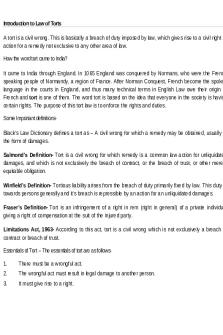Introduction to Sensitivity Analysis of Objective Function Coefficients PDF

| Title | Introduction to Sensitivity Analysis of Objective Function Coefficients |
|---|---|
| Course | Quantitative Methods In Admin |
| Institution | Florida Atlantic University |
| Pages | 3 |
| File Size | 159.7 KB |
| File Type | |
| Total Downloads | 33 |
| Total Views | 140 |
Summary
Sensitivity Analysis notes...
Description
Sensitivity Analysis of Objective Function Coefficients What is at stake: The optimal solution (values of the decision variables) of a linear program will remain the same for some range of the objective function coefficients. We want to know what that range is. Why?
Sensitivity on one Objective Function Coefficient
Sensitivity Analysis for EZCo graphically Sensitivity Analysis for EZCo via Solver Table Sensitivity Analysis for EZCo via Sensitivity Report Sensitivity Analysis for Wyndor via Solver Table Sensitivity Analysis for Wyndor via Sensitivity Report
Wyndor Example Wyndor makes doors and windows in three plants. The table below shows how many hours are consumed in the plants to make a door or a window, the number of hours available at each plant, the profit margin per door, and the profit margin per window.
How many doors and windows should Wyndor produce to maximize profits?
Sensitivity on two or more Objective Function Coefficients
Sensitivity Analysis for Wyndor via Solver Table The 100 Percent Rule for Simultaneous Changes in Objective Function Coefficients: If simultaneous changes are made in the coefficients of the objective function, calculate for each change the percentage of the allowable change (increase or decrease) for that coefficient to remain within its allowable
range. If the sum of the percentage changes does not exceed 100 percent, the original optimal solution definitely will still be optimal. (If the sum does exceed 100 percent, then we cannot be sure.)
Example 1: In the Wyndor example, assume that the profit of doors is increased from 300 to 450 (or 150), and the profit on windows has decreased from 500 to 400 (or 100). From the sensitivity report, the profit on doors can increase by 450, and the profit on windows can decrease by 300 before changing the solution. Then for doors: 450−300 150 1 = = 450 450 3
Fraction of allowable increase= And for windows: Fraction of allowable decrease=
So the total is
1 1 2 + = 3 3 3
500− 400 100 1 = = 300 300 3
or 67%. This is less than 100%, so the optimal solution will not
change.
Example 2: In the Wyndor example, assume that the profit of doors is increased from 300 to 600 (or 300), and the profit on windows has decreased from 500 to 300 (or 200). From the sensitivity report, the profit on doors can increase by 450, and the profit on windows can decrease by 300 before changing the solution. Then for doors: Fraction of allowable increase=
600 −300 300 2 = = 450 3 450
And for windows: Fraction of allowable decrease=
500−300 200 2 = = 300 3 300
2 2 4 + = or 133%. This is more than 100%, so we cannot tell if the optimal 3 3 3 solution will change or stay the same. (However, look at the result in Wyndor Simultaneous.)
So the total is
Question: Suppose we have a unit increase in the profit on doors from 300 to 525. What is the largest decrease in the profit on windows which we know will leave the optimal solution the same?
Fraction of allowable increase=
525 −300 225 1 = = 450 2 450
Let Pw be the new unit profit on windows. As long as the fraction of allowable decrease does not 1 1 exceed 1− = , then we know that the optimal solution will not change. Then 2 2 Fraction of allowable decrease=
500−Pw 1 = 2 300
Or Pw = 350.
In class exercise: (a) For the EZCo Problem, use Solver Table to compute the (1) profit and (2) optimal unit production as the profit unit on Aeros, PA, varies from 5.0 to 8.0 by 0.5, and the profit unit on Ballistics, PB, varies from 7.0 to 9.0 by 0.5. (b) Based on your results, what will happen to the optimal solution if PA goes from 6.0 to 7.5, while PB goes from 8.0 to 7.0? (c) What does the 100% rule say about this change? (d) Redo parts (b) and (c), if PA goes from 6.0 to 6.5, while PB goes from 8.0 to 7.0....
Similar Free PDFs

Sensitivity analysis 1
- 2 Pages

Sensitivity Analysis 2
- 2 Pages

Chapter 8 LP Sensitivity Analysis
- 31 Pages

Introduction to Law of Torts
- 14 Pages

Capabilities to Function Essay
- 2 Pages
Popular Institutions
- Tinajero National High School - Annex
- Politeknik Caltex Riau
- Yokohama City University
- SGT University
- University of Al-Qadisiyah
- Divine Word College of Vigan
- Techniek College Rotterdam
- Universidade de Santiago
- Universiti Teknologi MARA Cawangan Johor Kampus Pasir Gudang
- Poltekkes Kemenkes Yogyakarta
- Baguio City National High School
- Colegio san marcos
- preparatoria uno
- Centro de Bachillerato Tecnológico Industrial y de Servicios No. 107
- Dalian Maritime University
- Quang Trung Secondary School
- Colegio Tecnológico en Informática
- Corporación Regional de Educación Superior
- Grupo CEDVA
- Dar Al Uloom University
- Centro de Estudios Preuniversitarios de la Universidad Nacional de Ingeniería
- 上智大学
- Aakash International School, Nuna Majara
- San Felipe Neri Catholic School
- Kang Chiao International School - New Taipei City
- Misamis Occidental National High School
- Institución Educativa Escuela Normal Juan Ladrilleros
- Kolehiyo ng Pantukan
- Batanes State College
- Instituto Continental
- Sekolah Menengah Kejuruan Kesehatan Kaltara (Tarakan)
- Colegio de La Inmaculada Concepcion - Cebu










